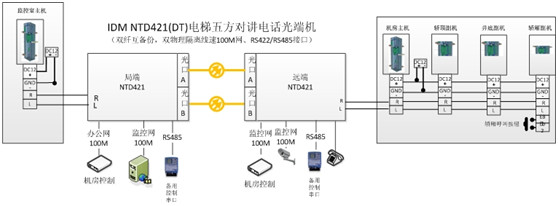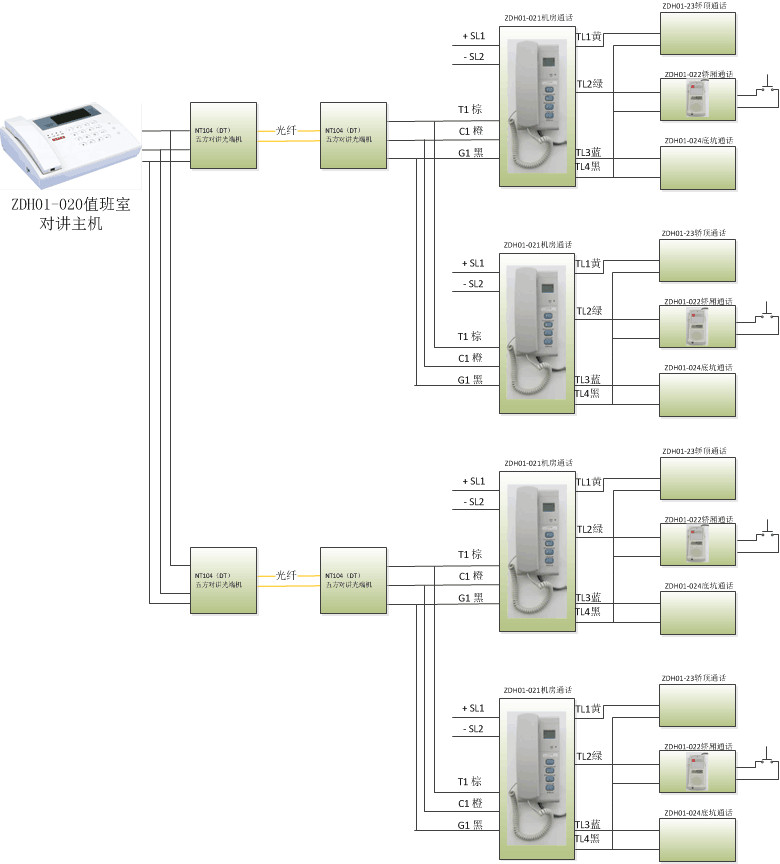Optical fiber transmission design of elevator intercom system
In 2004, the National elevator industry Standards Committee timely launched the new standard GB7588-2003 "Elevator Manufacturing and installation safety Code", and began to implement the standard nationwide in 2005. Article 5.10, 8.17.4, 8.17.5, 14.2.3 and 15.12 of the standard make clear provisions on the requirements of the elevator communication system. The standard not only makes requirements for the multi-party call of the single elevator communication system, but also makes specific provisions for the communication system in the multi-elevator cluster application. The introduction of the new standard has provided a scientific basis for the production, inspection and acceptance of elevator installation engineering of elevator communication system in elevator cluster application.
With the large-scale use of elevators, elevator communication system has also developed from a simple single elevator emergency call system. At present, the multi-elevator group communication system that can be networked in a large area makes dozens or even hundreds of elevator emergency call systems in large communities network together to form an elevator group communication system. In this system, each elevator has a fixed code, and each elevator in the car host, car top extension, pit extension, machine room extension in an emergency can call with the management center, management center can also call with any elevator in the car host, car top extension, pit extension, machine room extension. It can also make group calls and broadcast calls.
With the accumulation of technology for a long time, the elevator five-way intercom equipment is becoming more and more perfect, the elevator intercom equipment has formed low-cost, stable performance products, the main technology near the elevator is divided into, common intercom class (does not distinguish the terminal position), star intercom class (can distinguish the top of the car, the bottom of the car, the car room) two categories, the former technology is simple, cheap equipment. The corresponding central terminal equipment is different, the former corresponds to a multi-office through-key terminal (such as the commonly used Otis five-way intercom), and the latter is mostly a bus-dial terminal (such as the Mitsubishi five-way intercom).


The traditional five-way intercom is achieved by twisted pair, which determines that this system can not be transmitted far, for which some manufacturers use ISM band radio, because it is an amateur band, the rights and interests are not protected, and are susceptible to interference. There are also GSM remote transmission, which solves the problem of remote transmission, but it requires regular top-up, which is a big expense.
Through optical fiber or IP network elevator five-way intercom program, skills to solve the remote transmission problem, but also through one-time investment to save investment. At the same time, through the digital processing of the voice, it can be easily recorded, easily bound to the video surveillance system, and can also be connected to the wireless cluster walkie-talkie, fixed telephone, and mobile phone through the access to the multimedia command and dispatch system.
Five-way intercom optical fiber transmission equipment (referred to as five-way intercom optical terminal) provides an access channel for the existing elevator intercom equipment, and provides an audio channel for each elevator while keeping the original remote equipment unchanged (which terminal provides the current speech by signaling coding).
When optical transmission channels are provided, the devices at both ends remain unchanged. Only solved the transmission problem, did not enhance other aspects of the function. The system cost is high.
To this end, we provide a comprehensive solution for the terminal. On the central terminal device (DTZX), we provide 2 telephone interfaces, computer communication interfaces, emergency response buttons, indicators, alarm speakers, etc. It can network with other devices, expand more optical ports, and provide Ethernet interfaces for IP recording. Up to 120 elevators can be connected.
The emergency response button is used to connect the current alarm elevator automatically when no computer is involved (such as shutdown, crash, power failure, etc.). After processing, if the alarm light is still on, press the button again to connect the second alarm elevator.
Another advantage of using optical fiber is that each elevator has an independent channel, which will not compete for the voice bus, and it is convenient to record at the central end.
The optical fiber transmission system has the ability to automatically detect the lines of each power-saving device and automatically alarm the fault.
Central device function: any remote intercom device off-hook or alarm, the local device panel alarm light, send the channel number and alarm content to the PC, the corresponding button on the screen turns red, and the image information on the elevator will be displayed when binding the image. Press the corresponding button on the touch screen, the first phone and the elevator constitute a five-way conversation. If the first phone is busy (the call has been connected), the second phone is automatically connected (the call is directly connected if the phone is off the hook, and the phone rings if the phone is not off the hook).
The central end can directly call the remote end. Pick up the phone first and press the button corresponding to the elevator to realize a five-party conversation.
In case of emergency, press the emergency button, the center can broadcast to all elevators.
The PC can generate statistical reports.
There is an elevator data input box (you can input all elevator data of each building, as well as the maintenance personnel mobile phone number and cluster frequency), the alarm will display the specific location of the elevator (such as building number, elevator number, elevator number, floor number, etc.).








 86-18710178699
86-18710178699  xufei@rdtcom.com
xufei@rdtcom.com